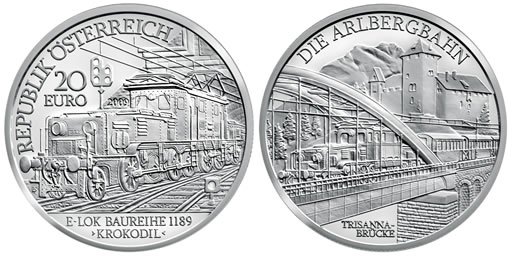The fifth coin in the series "Austrian Railways" to be issued on 17th June, 2009, is dedicated to the electric train. What began as a fair ground attraction in 1880 in the Vienna Prater rapidly became the most revolutionary step in transportation since the harnessing of steam almost a century before.

The first electric train in Austria was a small locomotive circling in the great exhibition pavilion in the Prater on the occasion of the Emperor Franz Joseph’s 50th birthday. The same monarch issued a licence two years later in 1882 for the first public electric railway.
It used direct current and was a five kilometer long stretch carrying day-trippers from the country town of Mödling into the popular Brühl valley. Other short branch lines soon followed. The introduction of alternating current proved the most reliable for longer railway lines, and in 1911 electric engines using alternating current were put into service on the 90 kilometer stretch to the pilgrimage centre of Mariazell.
These engines were to set the trend for future development and in 1913 an agreement between Austria, Germany, Switzerland, Sweden and Norway stipulated the use of alternating current of 15,000 volts. Unfortunately, other railways authorities did not follow suit and today Europe still has no unified electric rail transport.
The First World War interrupted further progress and brought to an end the Austro-Hungarian Monarchy in 1918. The new Austrian Republic found the problem of coal supplies for steam engines almost insurmountable and turned to an old imperial study on electrification of the railways.
In the 1920’s the alpine lines of the Arlberg railway and the Salzkammergut railway were converted. Electric power improved not only the performance on steep inclines but also freed staff and passengers from unpleasant smoke concentrations in tunnels. New engines were developed. One such was the model 1100 which, because of its appearance and green colour, was dubbed the "Crocodile".
Electrification went on until 1940 when the Second World War again brought it to a standstill. Bombing inflicted extensive damage to Austria’s railway lines, but the survival of hydro power stations enabled a rapid resumption of electric powered trains. The conversion of the major lines was completed in the 1950’s. By 1988 only 54% of Austrian lines were electric, but those lines carried 92% of the passenger and freight transport. The era of steam-driven locomotives was at an end.
The obverse of the new 20 Euro proof silver coin shows an electric engine model 1189 (also a "Crocodile") emerging from the western exit of the Arlberg tunnel. The reverse has one of the loveliest alpine railway scenes for its design: the spectacular Trisanna Bridge on the Arlberg line with Wiesburg Castle and the mountains towering behind. A passenger train pulled by the electric engine model 1100 is crossing the 231 meter long bridge, which at its opening in 1884 ranked as the then longest arched steel railway bridge in the world.
The new coin is struck in 900 fine silver in proof quality only. Each coin in an attractive box is accompanied by a numbered certificate of authenticity. A separate collection case for the six coin series is available for purchase.
The coin goes on sale on Wednesday, 17th June, 2009, and will be followed in September by a coin for "The Railway of the Future", which will complete the series on "Austrian Railways".
# # #
Austrian Electric Train coin specifiations
| Type: | Silver, 900/1000 Ag |
| Finish: | Proof |
| Diameter: | 34 mm |
| Weight: | ccccccccc |
| Fine Weight: | 18 g |
| Mintage: | 50,000 |
| Face Value: | 20 euro |
| Designer: | Th. Pesendorfer/H. Wähner |
About the Austrian Mint
The Austrian Mint is situated in the heart of Vienna and is the official minting authority for Austria with a 800 year history.
The Mint is the source for all Austrian Euro and Cent coins, whether they are intended for shopping, as an investment or for collection. Before the Euro, the Schilling and Groschen coins were minted, and before that – during the monarchy – Crowns, Guilders and Ducats were struck by the Austrian Mint.
The company is located close to the centre at the Vienna Stadtpark in a Biedermeier building erected under Emperor Ferdinand I. from 1835 to 1837. Today it accommodates one of the most modern mints in the world.





